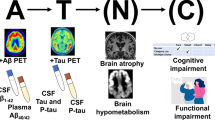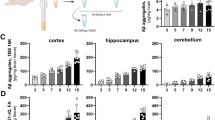Abstract
Amyloid-beta (Aβ) is suggested to play a causal role in the pathogenesis of Alzheimer’s disease (AD). Immunotherapies are among the most promising Aβ-targeting therapeutic strategies for AD. But, to date, all clinical trials of this modality have not been successful including Aβ vaccination (AN1792), anti-Aβ antibodies (bapineuzumab, solanezumab and ponezumab), and intravenous immunoglobulin (IVIG). We propose that one reason for the failures of these clinical trials may be the adverse effects of targeting the central clearance of amyloid plaques. The potential adverse effects include enhanced neurotoxicity related to Aβ oligomerization from plaques, neuroinflammation related to opsonized Aβ phagocytosis, autoimmunity related to cross-binding of antibodies to amyloid precursor protein (APP) on the neuron membrane, and antibody-mediated vascular and neuroskeletal damage. Overall, the majority of the adverse effects seen in clinical trials were associated with the entry of antibodies into the brain. Finally, we propose that peripheral Aβ clearance would be effective and safe for future Aβ-targeting therapies.

Similar content being viewed by others
References
Dodel R et al (2013) Intravenous immunoglobulin for treatment of mild-to-moderate Alzheimer’s disease: a phase 2, randomised, double-blind, placebo-controlled, dose-finding trial. Lancet Neurol 12:233–243. doi:10.1016/S1474-4422(13)70014-0
Doody RS et al (2014) Phase 3 trials of solanezumab for mild-to-moderate Alzheimer’s disease. N Engl J Med 370:311–321. doi:10.1056/NEJMoa1312889
Karran E, Hardy J (2014) Antiamyloid therapy for Alzheimer’s disease—are we on the right road? N Engl J Med 370:377–378. doi:10.1056/NEJMe1313943
Salloway S et al (2014) Two phase 3 trials of bapineuzumab in mild-to-moderate Alzheimer’s disease. N Engl J Med 370:322–333. doi:10.1056/NEJMoa1304839
Wang YJ (2014) Lessons from immunotherapy for Alzheimer disease. Nat Rev Neurol 10:188–189. doi:10.1038/nrneurol.2014.44
Wang YJ, Zhou HD, Zhou XF (2010) Modified immunotherapies against Alzheimer’s disease: toward safer and effective amyloid clearance. J Alzheimer Dis 21:1065–1075
DeMattos RB, Bales KR, Cummins DJ, Dodart JC, Paul SM, Holtzman DM (2001) Peripheral anti-A beta antibody alters CNS and plasma A beta clearance and decreases brain A beta burden in a mouse model of Alzheimer’s disease. Proc Natl Acad Sci U S A 98:8850–8855
DeMattos RB, Bales KR, Cummins DJ, Paul SM, Holtzman DM (2002) Brain to plasma amyloid-beta efflux: a measure of brain amyloid burden in a mouse model of Alzheimer’s disease. Science 295:2264–2267
Morgan D (2011) Immunotherapy for Alzheimer’s disease. J Int Med 269:54–63. doi:10.1111/j.1365-2796.2010.02315.x
Sperling R et al (2012) Amyloid-related imaging abnormalities in patients with Alzheimer’s disease treated with bapineuzumab: a retrospective analysis. Lancet Neurol 11:241–249. doi:10.1016/S1474-4422(12)70015-7
Carlson C et al (2011) Prevalence of asymptomatic vasogenic edema in pretreatment Alzheimer’s disease study cohorts from phase 3 trials of semagacestat and solanezumab. Alzheimer Dement 7:396–401. doi:10.1016/j.jalz.2011.05.2353
Gilman S et al (2005) Clinical effects of Abeta immunization (AN1792) in patients with AD in an interrupted trial. Neurology 64:1553–1562
Millucci L, Ghezzi L, Bernardini G, Santucci A (2010) Conformations and biological activities of amyloid beta peptide 25-35. Curr Protein Peptide Sci 11:54–67
Colletier JP et al (2011) Molecular basis for amyloid-beta polymorphism. Proc Natl Acad Sci U S A 108:16938–16943. doi:10.1073/pnas.1112600108
Mannix RC, Whalen MJ (2012) Traumatic brain injury, microglia, and Beta amyloid. Int J Alzheimer Dis 2012:608732. doi:10.1155/2012/608732
Dilger RN, Johnson RW (2008) Aging, microglial cell priming, and the discordant central inflammatory response to signals from the peripheral immune system. J Leukoc Biol 84:932–939. doi:10.1189/jlb.0208108
Pietri M et al (2013) PDK1 decreases TACE-mediated alpha-secretase activity and promotes disease progression in prion and Alzheimer’s diseases. Nat Med 19:1124–1131. doi:10.1038/nm.3302
Krstic D, Knuesel I (2012) Deciphering the mechanism underlying late-onset Alzheimer disease. Nat Rev Neurol 9:25–34. doi:10.1038/nrneurol.2012.236
Rhinn H, Fujita R, Qiang L, Cheng R, Lee JH, Abeliovich A (2013) Integrative genomics identifies APOE epsilon4 effectors in Alzheimer’s disease. Nature 500:45–50. doi:10.1038/nature12415
Ohtani S, Kohyama K, Matsumoto Y (2011) Autoantibodies recognizing native MOG are closely associated with active demyelination but not with neuroinflammation in chronic EAE. Neuropathology 31:101–111. doi:10.1111/j.1440-1789.2010.01131.x
Patton RL et al (2006) Amyloid-beta peptide remnants in AN-1792-immunized Alzheimer’s disease patients: a biochemical analysis. Am J Pathol 169:1048–63
Deng J et al (2012) Autoreactive-Abeta antibodies promote APP beta-secretase processing. J Neurochem 120:732–740. doi:10.1111/j.1471-4159.2011.07629.x
Dodel R et al (2011) Naturally occurring autoantibodies against beta-amyloid: investigating their role in transgenic animal and in vitro models of Alzheimer’s disease. J Neurosci 31:5847–5854. doi:10.1523/JNEUROSCI.4401-10.2011
Piazza F et al (2013) Anti-amyloid beta autoantibodies in cerebral amyloid angiopathy-related inflammation: implications for amyloid-modifying therapies. Ann Neurol 73:449–458. doi:10.1002/ana.23857
Bouras C, Riederer BM, Hof PR, Giannakopoulos P (2003) Induction of MC-1 immunoreactivity in axons after injection of the Fc fragment of human immunoglobulins in macaque monkeys. Acta Neuropathol 105:58–64. doi:10.1007/s00401-002-0617-6
Farlow M et al (2012) Safety and biomarker effects of solanezumab in patients with Alzheimer’s disease. Alzheimers Dement 8:261–271. doi:10.1016/j.jalz.2011.09.224
Bradshaw EM et al (2013) CD33 Alzheimer’s disease locus: altered monocyte function and amyloid biology. Nat Neurosci 16:848–850. doi:10.1038/nn.3435
Bard F et al (2012) Sustained levels of antibodies against Abeta in amyloid-rich regions of the CNS following intravenous dosing in human APP transgenic mice. Exp Neurol 238:38–43. doi:10.1016/j.expneurol.2012.07.022
Wang YJ et al (2010) Intramuscular delivery of a single chain antibody gene prevents brain Abeta deposition and cognitive impairment in a mouse model of Alzheimer’s disease. Brain Behav Immun 24:1281–1293. doi:10.1016/j.bbi.2010.05.010
Wang YJ et al (2009) Intramuscular delivery of a single chain antibody gene reduces brain Abeta burden in a mouse model of Alzheimer’s disease. Neurobiol Aging 30:364–376. doi:10.1016/j.neurobiolaging.2007.06.013
Fukumoto H, Deng A, Irizarry MC, Fitzgerald ML, Rebeck GW (2002) Induction of the cholesterol transporter ABCA1 in central nervous system cells by liver X receptor agonists increases secreted Abeta levels. J Biol Chem 277:48508–48513. doi:10.1074/jbc.M209085200
Hooijmans CR, Kiliaan AJ (2008) Fatty acids, lipid metabolism and Alzheimer pathology. Eur J Pharmacol 585:176–196. doi:10.1016/j.ejphar.2007.11.081
Lesser GT (2012) Association of Alzheimer disease pathology with abnormal lipid metabolism: the Hisayama Study. Neurology 78:1280. doi:10.1212/WNL.0b013e318254f6ad
Mahley RW (1988) Apolipoprotein E: cholesterol transport protein with expanding role in cell biology. Science 240:622–630
Zerbinatti CV, Bu G (2005) LRP and Alzheimer’s disease. Rev Neurosci 16:123–135
Kang DE et al (2000) Modulation of amyloid beta-protein clearance and Alzheimer’s disease susceptibility by the LDL receptor-related protein pathway. J Clin Invest 106:1159–1166. doi:10.1172/JCI11013
Deane R, Wu Z, Zlokovic BV (2004) RAGE (yin) versus LRP (yang) balance regulates alzheimer amyloid beta-peptide clearance through transport across the blood-brain barrier. Stroke 35:2628–2631
Koldamova R, Staufenbiel M, Lefterov I (2005) Lack of ABCA1 considerably decreases brain ApoE level and increases amyloid deposition in APP23 mice. J Biol Chem 280:43224–43235. doi:10.1074/jbc.M504513200
Koldamova RP et al (2003) 22R-hydroxycholesterol and 9-cis-retinoic acid induce ATP-binding cassette transporter A1 expression and cholesterol efflux in brain cells and decrease amyloid beta secretion. J Biol Chem 278:13244–13256. doi:10.1074/jbc.M300044200
Liu Y et al (2009) Expression of neprilysin in skeletal muscle reduces amyloid burden in a transgenic mouse model of Alzheimer disease. Mol Ther 17:1381–1386. doi:10.1038/mt.2009.115
Torkhovskaia TI, Ipatova OM, Medvedeva NV, Zakharova TS, Khalilov EM (2006) Membrane proteins and phospholipids as effectors of reverse cholesterol transport. Biomed Khim 52:113–123
Zarubica A, Trompier D, Chimini G (2007) ABCA1, from pathology to membrane function. Pflugers Arch 453:569–579. doi:10.1007/s00424-006-0108-z
Sparks DL (2007) Cholesterol metabolism and brain amyloidosis: evidence for a role of copper in the clearance of Abeta through the liver. Curr Alzheimer Res 4:165–169
Tamaki C, Ohtsuki S, Terasaki T (2007) Insulin facilitates the hepatic clearance of plasma amyloid beta-peptide (1 40) by intracellular translocation of low-density lipoprotein receptor-related protein 1 (LRP-1) to the plasma membrane in hepatocytes. Mol Pharmacol 72:850–855. doi:10.1124/mol.107.036913
Seliger SL et al (2004) Moderate renal impairment and risk of dementia among older adults: the Cardiovascular Health Cognition Study. J Am Soc Nephrol 15:1904–1911
Li J et al (2011) Vascular risk factors promote conversion from mild cognitive impairment to Alzheimer disease. Neurology 76:1485–1491. doi:10.1212/WNL.0b013e318217e7a4
Li J et al (2010) Vascular risk aggravates the progression of Alzheimer’s disease in a Chinese cohort. J Alzheimers Dis 20:491–500. doi:10.3233/JAD-2010-1383
Arvanitakis Z, Lucas JA, Younkin LH, Younkin SG, Graff-Radford NR (2002) Serum creatinine levels correlate with plasma amyloid Beta protein. Alzheimer Dis Assoc Disord 16:187–190
Stanyon HF, Viles JH (2012) Human serum albumin can regulate amyloid-beta peptide fiber growth in the brain interstitium: implications for Alzheimer disease. J Biol Chem 287:28163–28168. doi:10.1074/jbc.C112.360800
Naj AC et al (2011) Common variants at MS4A4/MS4A6E, CD2AP, CD33 and EPHA1 are associated with late-onset Alzheimer’s disease. Nat Genet 43:436–441. doi:10.1038/ng.801
Kiko T et al (2012) Amyloid beta levels in human red blood cells. PloS one 7:e49620. doi:10.1371/journal.pone.0049620
Lucas HR, Rifkind JM (2013) Considering the vascular hypothesis of Alzheimer’s disease: effect of copper associated amyloid on red blood cells. Adv Exp Med Biol 765:131–138. doi:10.1007/978-1-4614-4989-8_19
Rogers J et al (2006) Peripheral clearance of amyloid beta peptide by complement C3-dependent adherence to erythrocytes. Neurobiol Aging 27:1733–1739
Boada M et al (2009) Amyloid-targeted therapeutics in Alzheimer’s disease: use of human albumin in plasma exchange as a novel approach for Abeta mobilization. Drug News Perspect 22:325–339. doi:10.1358/dnp.2009.22.6.1395256
Sehgal N et al (2012) Withania somnifera reverses Alzheimer’s disease pathology by enhancing low-density lipoprotein receptor-related protein in liver. Proc Natl Acad Sci U S A 109:3510–3515. doi:10.1073/pnas.1112209109
Guan H et al (2008) Peripherally expressed neprilysin reduces brain amyloid burden: a novel approach for treating Alzheimer’s disease. J Neurosci Res. doi:10.1002/jnr.21944
Liu Y, Studzinski C, Beckett T, Murphy MP, Klein RL, Hersh LB (2010) Circulating neprilysin clears brain amyloid. Mol Cell Neurosci 45:101–107. doi:10.1016/j.mcn.2010.05.014
Henderson SJ et al (2013) Sustained peripheral depletion of amyloid-beta with a novel form of neprilysin does not affect central levels of amyloid-beta. Brain. doi:10.1093/brain/awt308
Walker JR et al (2013) Enhanced proteolytic clearance of plasma Abeta by peripherally administered neprilysin does not result in reduced levels of brain Abeta in mice. J Neurosci 33:2457–2464. doi:10.1523/JNEUROSCI.3407-12.2013
Liu Y et al (2007) In vitro and in vivo degradation of Abeta peptide by peptidases coupled to erythrocytes. Peptides 28:2348–2355. doi:10.1016/j.peptides.2007.09.015
Acknowledgment
This work was supported by the National Natural Science Foundation of China (grant no. 81270423 and 30973144) and the Natural Science Foundation Project of CQCSTC (grant no. CSTC2010BA5004). The authors thank N. Wei at Daping Hospital of Third Military Medical University for assistance with creating the figures and Ms Kate Rees from University of South Australia for critical reading of the manuscript.
Conflict of Interest
None.
Author information
Authors and Affiliations
Corresponding author
Rights and permissions
About this article
Cite this article
Liu, YH., Wang, YR., Xiang, Y. et al. Clearance of Amyloid-Beta in Alzheimer’s Disease: Shifting the Action Site from Center to Periphery. Mol Neurobiol 51, 1–7 (2015). https://doi.org/10.1007/s12035-014-8694-9
Received:
Accepted:
Published:
Issue Date:
DOI: https://doi.org/10.1007/s12035-014-8694-9




